
| WWT Shows | CLICK TO: Join and Support Internet Horology Club 185™ | IHC185™ Forums |

|
• Check Out Our... • • TWO Book Offer! • |
Welcome Aboard IHC185™  Internet Horology Club 185
Internet Horology Club 185  IHC185™ Discussion Site Main Page
IHC185™ Discussion Site Main Page  Interesting Horologically Based Stories
Interesting Horologically Based Stories  "The Time Zone"... STORIES
"The Time Zone"... STORIES  Kipton Train Crash April 18, 1891
Kipton Train Crash April 18, 1891
 Internet Horology Club 185
Internet Horology Club 185  IHC185™ Discussion Site Main Page
IHC185™ Discussion Site Main Page  Interesting Horologically Based Stories
Interesting Horologically Based Stories  "The Time Zone"... STORIES
"The Time Zone"... STORIES  Kipton Train Crash April 18, 1891
Kipton Train Crash April 18, 1891Go  | New Topic  | Find-Or-Search  | Notify  | Tools  | Reply to Post  |  |
| IHC Life Member Site Moderator |
Well I really wasn't to sure where to post this but I thought perhaps in this form. I have been trying to locate what information I could one the crash in Kipton Ohio between the fast mail train & the passenger train on April 18, 1891. Since this is the crash that most people credit with the start of the regulations for watch quality & inspection. This 1st article is from the Sandusky Daily Register April 20, 1891. One thing to note is the name of the engineer killed listed as Edward Brown, in the official report of the accident he is listed as Emory Eugene Bacon & also in later articles. I haven't run across where a correction was made in the press, it is just one day there is a Brown & the next Bacon. 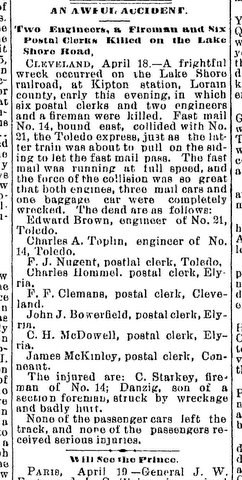 | ||
|
| IHC Life Member Site Moderator |
I hope this article is readable, it was from a passenger on the mail train & I thought interesting. One thing of note is he talks about the engineers watch still running when his body was found, that is different than the investigation, they report the watch found but stopped at a certain time but not run down, more that it stopped due to the crash. This article is from the same paper on the same day April 20, 1891 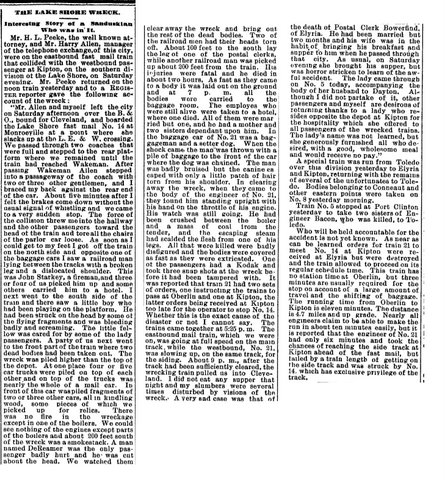 | |||
|
| IHC Life Member Site Moderator |
Article from same paper dated April 22, 1891. 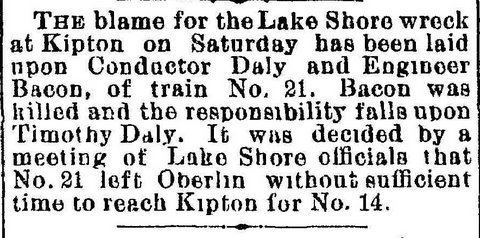 | |||
|
| IHC Life Member Site Moderator |
This is the depot at Kipton.  | |||
|
| IHC Life Member Site Moderator |
Photo of the crash scene 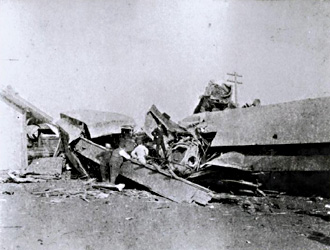 | |||
|
| IHC Life Member Site Moderator |
Another 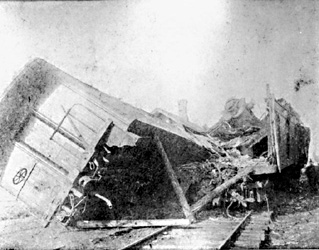 | |||
|
| IHC Life Member Site Moderator |
Marker at the site. 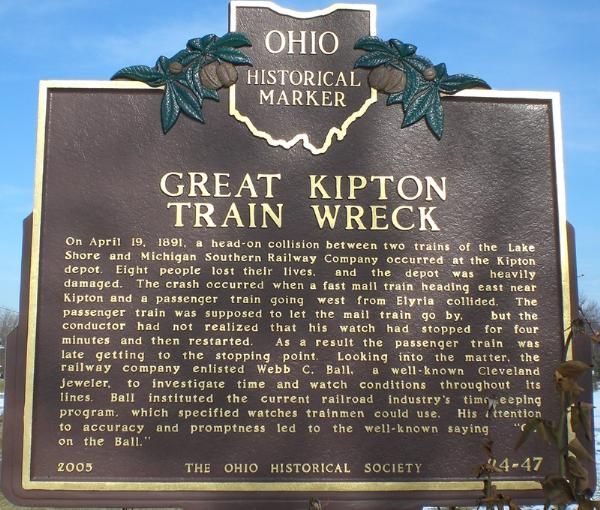 | |||
|
| IHC Vice President Pitfalls Moderator IHC Life Member |
Good stuff Tom. As for the factual anomalies, a reporter facing a deadline may have made things up if he didn't know the real facts, a longstanding journalistic tradition. Best Regards, Ed | |||
|
| IHC Life Member Site Moderator |
Here is the report about the accident. At the end it mentions the engineer's watch & that a diagram was made of the watch, I would like to find a copy of that. I think it would be interesting to know what it was & if it has the serial number listed, just so if some chance it ever resurfaced. REPORTS OF INSPECTOR IN RELATION TO VARIOUS RAILROAD ACCIDENTS. Hon. T. A. Norton, Commissioner of Railroads and Telegraphs: My Dear Sir: In accordance with your instructions on the 19th inst., I went immediately to Kipton, and commenced investigating the cause of the disaster which occurred at that place on the Lake Shore and Michigan Southern Railroad, on Saturday, April 18, 1891, by the collision of the east bound fast mail train No. 21, in which eight persons were killed—six mail clerks and two engineers. The location where the accident occurred is directly in front of the passenger station, a small frame building twenty-five by fifty feet, with a bay window in front, to enable the operator to see the trains in each direction, which is located on the south side of the main track. There is also a very light curve, which is about 11,460 feet radius, in the track at this point. The curve begins at a point 650 feet west of passenger station, and extends to a point 1,000 feet east of beginning, or 350 feet east of passenger station. The curve winds to the north and the passenger station is on the outer side o the curve. There are two sidetracks in front of the passenger house, and on the north side of the main track, one of which is a main sidetrack and the outer one a spur track. The main siding is next to the main track and intersects the same at the three following points: 688 feet east of passenger house on straight line; 312 feet west of passenger station on curve on level track; and 3,262 feet west of passenger house on straight line at foot of grade. The main track is nearly level from a point 1,050 feet west of passenger depot to the passenger depot, and also from the passenger station for some distance east of east switch, at intersection of main track, and commencing at the point 1,050 feet west of the depot. The track is down grade, running west for a distance of about 2,000 feet into a sag, and from this point there is a steep up grade running west for some distance. The switch known as the "Cross Over" switch, at a point 312 feet west of passenger house, is the one used by west-bound trains, which have the right of road over them. It is this switch that train No. 21 always used whenever it met train No. 14 at Kipton, and which it was attempting to make when the collision occurred. The sidetrack from the cross over switch west is used for the passage of trains, and from the cross over switch east it is used for storing cars. The spur track is north of the main siding, and extends from a point seventy-five feet west of passenger house to a point 725 feet east, where it intersects the main siding. Both side tracks were full of freight cars on the day of the accident, from a point seventy-five feet west of passenger house to a point about 600 feet east, which obstructed the view in each direction, and prevented the engineers of trains Nos. 21 and 14 from seeing each other's trains at a greater distance than about 900 feet, and it is not certain that they saw each other's trains even at that distance before they struck. While the location and the situation of the surroundings in regard to obstructing the view of the trains, in my opinion, had nothing whatever to do with the real cause of the accident, it is proper that they be made known for the purpose of showing, to some extent, what obstacles were in the way of averting the collision after the mistake had been made which caused it. I made a thorough investigation of every thing pertaining to the immediate cause of the accident, and left nothing undone, which I thought would throw any light upon it. I talked with conductor Daly, of train No. 21, and conductor Barnes, of train No. 14, also the different station agents, telegraph operators and the train dispatcher, with regard to sending or receiving any train orders governing trains Nos. 14 and 21 on the day of the accident. Mr. J. P. Malcolm, train dispatcher at Cleveland, stated that an order was sent to Norwalk and Elyria for trains No. 21 and No. 14 to meet at Kipton, and when No. 21 got to Elyria, Mr. Malcolm asked the operator what time it would get out, and the operator answered about 4:27 or 4:28; then Mr. Malcolm told him to destroy the order. There had been no O.K. given to the order, and no copies delivered to the engineers or conductors. He said he also told the operator at Norwalk to destroy his order for No. 14, and knew nothing more of the matter until the operator at Oberlin, the first station east of Kipton, reported, No. 21 out at 4:46, and Wakeman, the first station west of Kipton reported No.14 passing there at 4:45, right on time. The train dispatcher then commenced calling: Kipton, but received no answer until after the collision occurred. The distance from Oberlin to Kipton is about four and one-half miles, and from Kipton to Wakeman five miles. Train No. 14 is due at Oberlin at 4:38, and at Kipton at 4:49 and 4:52, allowing it three minutes to go on the sidetrack to clear No. 14. This gives it eleven minutes to make the run of four and six-tenths miles, so, according to train dispatcher Malcolm's statement, and also that of the operator at Oberlin, train No. 21 was eight minutes late out of Oberlin, which would only leave it three minutes to make the run of four and six-tenths miles, and get to Kipton on time, at 4:49, which would be impossible, and the only conclusion I can arrive at, if the statement of the train dispatcher and the operator at Oberlin is correct, is, that the conductor and engineer of train No. 21 must have counted on using the three minutes allowed No. 21 on the time table, for going on the side track to clear No. 14, or their watches must have been wrong, but if they counted upon the three minutes, it would only give them six minutes to make the run, stop for the switch and clear No. 14, which was due there at 4:52. Conductor Daly stated that it requires about one and one-half minutes for No. 21 to go upon the sidetrack; this being the case, it would only leave them four and one-half minutes running time. The operator at Elyria testified that No. 21 arrived there at 4:19 and left at 4:27, eight minutes late; also that he gave conductor Daly a clearance card and told him there were no orders for him against No. 14, that it was right on time. The operator at Oberlin testified that No. 21 arrived there at 4:44 and left at 4:46, eight minutes late. Conductor Daly testified that he left Elyria at 4:25, arrived at Oberlin at 4:41 and left at 4:43, five minutes late. The distance from Elyria to Oberlin is about nine miles, and from Oberlin to Kipton about four and one-half miles, making a total of about thirteen and one-half miles from Elyria to Kipton. Train No. 21 made two stops in that distance and did work. One at the C., L. & W. crossing and one at Oberlin, which consumed about two minutes at each place, and according to conductor Daly's testimony, would give him fourteen minutes running time from Elyria to Oberlin, and six minutes from Oberlin to Kipton depot, the time No. 21 is due there. Conductor Daly also testified that he made up four minutes between Oberlin and Kipton, and arrived at Kipton at 4:50. This would be impossible, because it would only give him three (3) minutes to run four and one-half miles according to his own statement of leaving Oberlin at 4:43, and the time was consumed in making the run between the two points, arriving at Kipton at 4:50. He also testified that he went to the engineer at Oberlin and asked him if he could make Kipton for No. 14, and the engineer said he could. This being true, the engineer must have erred, as well as the conductor, and was equally responsible with the conductor, according to rule No. 6 of the general rules of the L. S. & M.S. R.R. The evidence clearly shows that they did not have sufficient time to go to Kipton before No. 14, and should have remained at Oberlin. They also used very bad judgment by not stopping their train and sending back a flagman when they found that they were so close on train No. 14's time going into Kipton, that they could not make the switch with safety, knowing as well as they did the location and the obstacles that were in the way which would prevent the engineers of both trains from seeing each other except for a short distance in the vicinity of the depot. The evidence also shows that the engineer of train No. 14 did not see the semaphore, if it was put up at the time the operator at Kipton said it was, which was when No. 14 was at a point about 1,000 feet west of the passenger station. If he had he might have been able to stop, but as that was at the point where train No. 21 always stood upon the side track whenever it met No. 14 at Kipton, it is reasonable to suppose that when he did not see it there he must have thought that it was at Oberlin and put on a full head of steam, and the smoke may have to some extent prevented him from seeing the semaphore, as he was running at the rate of about forty-five miles per hour. Train No. 14 does not stop at Kipton only upon a special order to meet another train, and the time-card specifies that it has the right of track over No. 21. The testimony also shows that No. 14 was three minutes late leaving Norwalk, and that one minute was made up between there and Kipton, although the operator at Wakeman, five miles west of Kipton, reported it passing that station on time. This is disputed by train dispatcher Malcolm, who claims that it was impossible for No 14 to make up three minutes between Norwalk and Wakeman, on account of the steep grade, the distance being eleven and three-tenth miles and the regular running time eighteen minutes with a train of five cars. Conductor Barnes, of No. 14, testified that when passing the west switch, which is 3,262 feet west of Kipton Station, he looked at his watch and it was 4:54 ; so by making allowance of one minute and twenty seconds, which he stated that his watch was too fast, it would fix the correct time of passing the west switch at 4:52 and forty seconds, and would make the time of the trains coming together at about 4:53 ½ , by allowing the train one minute and a half to run 3,262 feet. He also testified that No. 14 was always late at Kipton, and that the rate of speed was about forty miles per hour when passing Kipton switch on the day of the accident; so by making a reasonable allowance for any errors in the evidence given in regard to No. 14 from the time it left Norwalk until it got to Kipton, it would be safe to say that the collision occurred between 4:52 and 4:54 P. M. Victor Hiss, fireman on train No. 21, testified that when they were within 1,000 feet of the passenger house he heard engineer Bacon say they had two minutes yet to make the switch, and in one-half minute more No. 14 came in sight, and he, the fireman, promptly jumped from the engine at the east end of the depot. ENGINEER BACON'S WATCH. On April 22, four days after the accident occurred, engineer Bacon's watch was found by one of the section men while clearing away rubbish a little east of the passenger station at Kipton. It showed that it had stopped at 4:41 ½ . I was informed that it was not run down and as to whether it was stopped before the train left Oberlin or from some cause at the time of the collision I cannot say. Enclosed please find a diagram of it showing the position of the hands just as it was found ; also copies of affidavits concerning the same. I also send you a blue print, which shows the location of the accident and the tracks, buildings, etc., described in my report. Messrs. P. P. Wright, General Superintendent, W. H. Canniff, Assistant General Superintendent, and J. M. Watts, Division Superintendent, gave me every assistance possible in making the investigation and were untiring in their efforts to find out the true cause of the accident. RECOMMENDATIONS. The rules in force for the management of trains on the L. S. & M. S. R. R. are about the same as those in use upon all other first-class roads in the country, and are all right if complied with and proper judgment used by every one having charge of trains. It is therefore unnecessary for me to offer any suggestions by way of recommendation as a precautionary measure against future accidents, except it be that a difference of at least five minutes be allowed in the time of all first-class passenger, fast mail and express- trains at their regular meeting points, where one train has the right of track over the other and does not come to a full stop, and that the train not having the right of track must not, under any circumstances, use more than three minutes of this time and must be clear of the main track at least two minutes before the train having the right of the track is due; the other three minuses to be used only for getting on side track and never for running time between stations. The trains having the right of track should also approach stations at meeting points with other trains at full control. Respectfully submitted, M. J. MCINARNA,. Inspector | |||
|
| Powered by Social Strata |
| Your request is being processed... |
|
Welcome Aboard IHC185™  Internet Horology Club 185
Internet Horology Club 185  IHC185™ Discussion Site Main Page
IHC185™ Discussion Site Main Page  Interesting Horologically Based Stories
Interesting Horologically Based Stories  "The Time Zone"... STORIES
"The Time Zone"... STORIES  Kipton Train Crash April 18, 1891
Kipton Train Crash April 18, 1891
 Internet Horology Club 185
Internet Horology Club 185  IHC185™ Discussion Site Main Page
IHC185™ Discussion Site Main Page  Interesting Horologically Based Stories
Interesting Horologically Based Stories  "The Time Zone"... STORIES
"The Time Zone"... STORIES  Kipton Train Crash April 18, 1891
Kipton Train Crash April 18, 1891©2002-2025 Internet Horology Club 185™ - Lindell V. Riddle President - All Rights Reserved Worldwide

